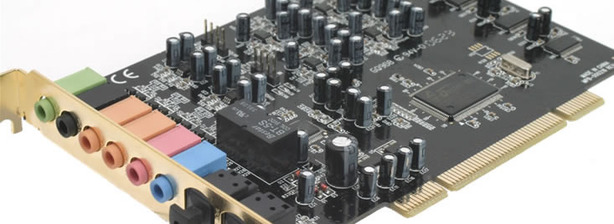
High Fidelity Heaven?
First of all, we're by no means audiophiles. We're technical enthusiasts, that's for sure, but at the end of the day we're still normal Joes that have let our precious ear drums be abused by headphones and live music, whilst owning iPods’ containing compressed music and sitting in rooms full of fans and ambient noise.To test however, we took to somewhere a lot quieter and played a range of music, games and movies, compressed and uncompressed; typically what a normal user would put this card through. We compared the Inferno to the Realtek ALC882M on the Abit AW8-MAX, which is "onboard sound" but is situated on its own daughter card supposedly offering higher quality sound, and the Creative X-Fi Fatal1ty edition soundcard. Admittedly the Fatal1ty edition does cost more and contains X-Ram but the same basic core X-Fi chip is used throughout the range including the Music edition X-Fi which is cheaper than the Inferno, so it should provide an overall idea of where it fits into given the extremes of the most commonly used audio processors.
Music
- A Perfect Circle: 400KBps ogg vbr
- Daft Punk: 128KBps AAC
- Dragonforce: Flac, compression level 7 and Mp3 160KBps
- Foo Fighters: 192KBps Mp3 vbr
- St Germain: 128KBps Mp3
- Royksopp: Flac, compression level 7
X-FI General music listening: During A Perfect Circle I could hear the movement of Jeordie White's hand up and down the bass strings on "The Package", something I hadn't picked out before and the sounds of the individual instruments were extremely clear. Listening to low bitrate, lossy compression and high bitrate lossy or lossless compressed music made a clear and noticeable difference in quality and clarity. The bass was strong and even and didn't distort the other sounds. Enabling "24bit Crystalliser" made some difference to the sound, most notably in Daft Punk where it just seemed to turn up the sound with a weighting to the bass.
The greatest effect was enabling CMSS-3D Headphones which seemed to separate the audio, allowing better differentiation between sounds and a better overall experience, but moving it anywhere from 50% weighting front to "surround" detrimentally affected the audio quality.
The Realtek ALC882M offers a less full experience with less differentiation between lossy and lossless music. Enabling Dolby Headphones helps but doesn't seem to have the complete overall effect that it does on the Inferno.
In comparison the Inferno sounds fantastic with a great bass, even without Dolby Headphone enabled. In comparison, not enabling the 24bit Crystalliser on the X-Fi offers a somewhat disappointing experience whilst the best experience on the Inferno was enabling Dolby Headphone and 7.1 Virtual Speaker Shifter. Just enabling the Dolby Headphone caused a muffling of the sound and just enabling the 7.1 Shifter caused the sound to come across distorted, however, having them both together just provided an experience that just 'worked' with vibrant bass (notably on Daft Punk) and clear, separated audio (the quick breaths whilst playing the flute in St. Germains, "So Flute").

- The Transporter 2: DivX with 128KBps Mp3
- Silent Hill DVD: 48KHz 5.1 channel 448KBps AC3
Silent Hill, as a horror movie, has some select and intense ambient sounds, plenty of vocals and scenes of quietness with sudden sharp sounds to create a tense atmosphere. Listening to AC3 audio was a solid and full experience with very little static noise in the quiet scenes. The Inferno required everything to be turned off for this when listening through headphones and then also remembering to turn off PowerDVDs own Audio post processing helped the fidelity. Even Dolby Headphone seemed to affect the AC3 audio in a negative way.
The Transporter has gunshots, engine and ambient noises as well as a lot of vocal work and some explosions: your typical action movie. The X-Fi offered a full bass with a good range of audio fidelity despite it being only 128KBps Mp3. The Inferno again sounds better without any of the extras turned on, despite the fact it's "low fidelity" Mp3 audio. Enabling anything caused unnecessary echo or unclear voices, but having said that, without anything on it still sounded superb and cinema-esque considering the quality of audio it was being supplied with.
Listening to the movies on the Realtek ALC882M onboard HD audio was, again, a less intense experience. It's something you can easily get used to and not consider that it gets any better because it's not noticeably bad in any way, but it's not spectacular either. It's just as you'd expect watching it on your PC or TV to be like, rather than the bringing in a bit of that cinema experience.
Games
- Broken Sword 4 (no EAX)
- Quake 4 (X-Ram and EAX 5 Advanced HD)
In Quake 4, EAX is obviously going to offer more environmental effects if it's coded into the game specifically for the X-Fi, whereas the Inferno has to "guess" at the same thing. It can't tell if you're in an enclosed environment, a steel room or muffling sounds behind a door as it's effects are post processing not game coded. Sure, it does offer some basic EAX functions in EAX 1 and 2, but not the Advanced EAX HD that the X-Fi offers. If you're a heavy gamer then the X-Fi is really the only option here.

MSI MPG Velox 100R Chassis Review
October 14 2021 | 15:04








Want to comment? Please log in.